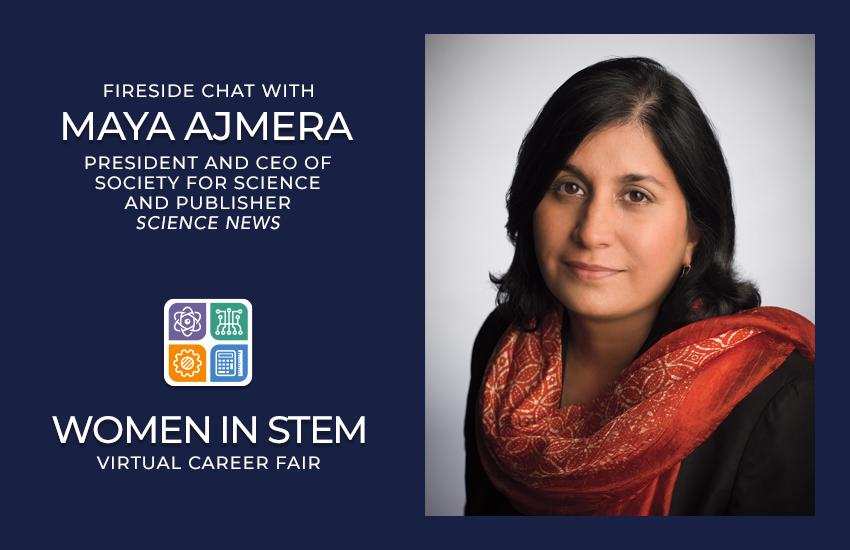Women in STEM Career Fair: Fireside Chat with Society for Science CEO Maya Ajmera
Published: Sep 13, 2021

Maya Ajmera is president and CEO of Society for Science and publisher of its award-winning magazine, Science News. She’s also the recipient of the 2020 National Science Board Public Service Award, recognized for her tremendous contribution to increasing the public’s understanding of science and engineering. Recently, Maya participated in a fireside chat at the Vault/Firsthand’s Women in STEM Career Fair. Here are five key things we learned from her.
1. Don’t think about what you want to be when you grow up. Think about what problem you want to solve.
Once you start thinking about the problem you want to solve, the motivation and passion come very naturally, which makes it a lot easier to figure out where you want to go. For example, on a trip to India, Maya discovered that a woman had created a school on a train platform where children were already living. Maya was captivated by this woman’s innovation and wanted to understand how someone could generate capital for innovative, grassroots organizations such as this school. Maya abandoned her studies to become an MD and went on to receive her Masters of Public Policy at Duke. At 24 years old, Maya then founded the Global Fund for Children and worked there for 17 years, sourcing $50 million dollars for 800 grassroots organizations.
2. There are five things holding us back from blazing a path forward for more women in STEM.
The first thing is “double competence”—when young women feel a great pressure to prove their professional worth, repeatedly. The second is “lack of mentorship,” particularly when women are un able to see themselves in any potential mentors. The third is “stereotype threat/implicit bias,” which often leads to harassment or bullying. The fourth is “income Inequality.” And the fifth is the “fundamental misunderstanding of motherhood/family.”
3. Read Raj Chetty’s article “The Lost Einsteins.”
Dr. Chetty’s work includes the study of “Lost Einsteins,” which is a reference to young people who could “have had highly impactful innovations” had they been able to pursue the opportunities they deserved.
4. Investment in the Women in STEM pipeline is absolutely critical.
When it comes to making meaningful change and creating a level playing field for women in STEM, it starts at the micro level. Maya uses the Science Talent Search as an example: “Started in 1942 as the Westinghouse Science Talent Search, the Regeneron Science Talent Search (Regeneron STS) recognizes and empowers our nation’s most promising young scientists who are developing ideas that could solve society’s most urgent challenges.”
Maya points to the Regeneron STS winners of the 1940s and 1950s—white, American men. In the last five years, four of the top STS winners have been women, two have been Asian, and one has been Hispanic. “We’re building the pipeline,” Maya said. “And if you can’t build the pipeline from the very beginning, you’re never going to get it at the Microsofts or the Googles.” We have to invest in young women and young women of color.
5. How young women in STEM can be successful in the workplace.
First, when you begin working with a company or a start-up, see how many women and individuals of color are on staff, and then ask: What is the company’s policy and commitment to diversity in the workplace? Second, develop a “posse” of other women who are working in the company. Third, speak up. Fourth, look for a mentor—how do you find a mentor if you don’t see yourself in any of your colleagues? And finally, be persistent!
Watch the entire fireside chat with Maya Ajmera at the Vault/Firsthand Women in STEM Career Fair here:
